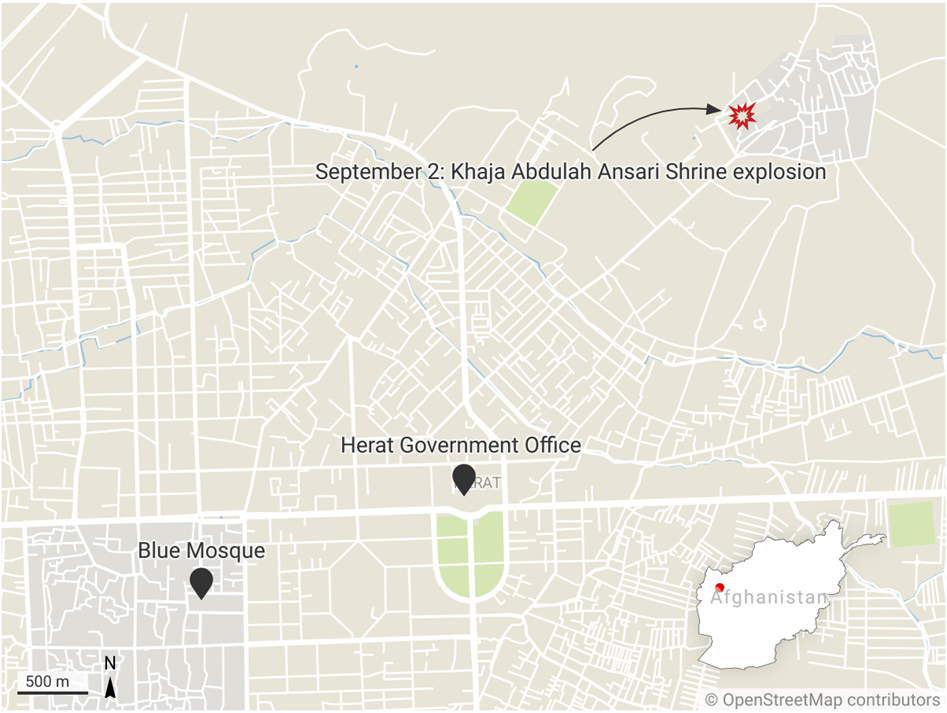On September 2, an explosion was reported at the Gazargah mosque in Herat. Officials said pro-Taliban cleric Maulavi Mujib ur-Rahman Ansari was among the 18 people killed, and that Ansari died alongside his brother, members of his security detail and civilians gathered for prayers in a suspected suicide blast.
The attack is yet to be claimed, however, Islamic State Khorasan Province (ISKP) have previously made threats against the pro-Taliban cleric. If ISKP are the perpetrators of the attack, this will be the third scholar killed by the group in the past month. On August 11, Sheikh Maulavi Rahimullah Haqqani was killed in a targeted explosion in Kabul, and on August 17, Maulavi Amir Mohammad Kabuli was killed in a mosque in Kabul.
 Location of Khaja Abdulah Ansari Shrine, PD8 Herat [34.374616, 62.240370]
Location of Khaja Abdulah Ansari Shrine, PD8 Herat [34.374616, 62.240370]
Local officials say at least 23 people were wounded in the attack, but local reports suggest the total casualty figure could be significantly higher.
A video shared by a journalist on Twitter shows the aftermath of the explosion. AW investigators were able to geolocate the footage, showing a large number of casualties, to the Khaja Abdulah Ansari Shrine in Herat’s police district (PD) 8.
 Geolocation of video showing the aftermath of the explosion at the Khaja Abdulah Ansari Shrine, PD8 Herat [34.374616, 62.240370]
Geolocation of video showing the aftermath of the explosion at the Khaja Abdulah Ansari Shrine, PD8 Herat [34.374616, 62.240370]
 Geolocation of image showing the aftermath of the explosion at the Khaja Abdulah Ansari Shrine, PD8 Herat [34.373844, 62.239878]
Geolocation of image showing the aftermath of the explosion at the Khaja Abdulah Ansari Shrine, PD8 Herat [34.373844, 62.239878]
Photos and a video show a large number of family members of the dead and wounded outside the Herat Seminary Hospital. According to Hamid Haidari, an Afghan former news editor, officials at the Herat hospitals claimed that there were 47 dead and 84 injured in the explosion.
Senior members of the Taliban have already commented on the killing of Ansari, including Taliban Spokesperson Zabihullah Mujahid, and senior Doha-based Taliban member, Suhail Shaheen. State media outlets RTA Pashto and Kabul News TV both tweeted statements about the death of Ansari. On Twitter, Mujahid’s tweet announcing the death received over 3000 engagements at the time of writing.
Background: Maulavi Muhjib ur-Rahman Ansari
In 2020, the New York Times described Ansari as the “radical cleric” from Herat ‘igniting an Islamist resistance in Afghanistan’. According to the article, Ansari had carved out his own conservative constituency in the neighbourhood of Gazargah, the same area where the explosion on September 2 occurred. Ansari, who was reportedly 36 at the time of the article, had no previous relationship with the Taliban, however, his teachings show strong similarities with the group.
Despite the similarities and his local implementation of strict Sharia law, the provincial Governor of Herat at the time, Abdul Wahid Qatali, stated that the government took no action against him, as he hadn’t picked up arms against them, and they did not want to “expend energy fighting this mullah.”
The New York Times stated that Ansari’s followers believed he was a descendant of an 11th-century Sufi saint named Abdullah Ansari of Herat. The tomb of Saint Ansari is reportedly close to the mosque where the attack took place.
Ansari announced his support to the Taliban just prior to their takeover in 2021. Since then, his relationship to central leadership has grown increasingly close, as he carved out a powerful position for himself. During the Loya Jirga (scholars conference) in late June and early July, he was one of the scholars invited to speak. In his speech, he argued that all those who oppose the Taliban’s governance should be beheaded.
When speaking on punishing those who oppose the Taliban at the Loya Jirga, Ansari made many references to the ISKP, which likely made him a target for the group. On July 17, the ISKP al-Azaim foundation published a video titled “The Deadly Streets”. Although Ansari was not specifically mentioned in the video, it does feature footage of him claiming that he has “issued fatwas from [his] rotten stomach”. In another video released on July 29 called “The Meeting of Polytheists”, ISKP claims that all those who attended the scholars conference are “evil scholars”. He was also reportedly mentioned in their 62-page book condemning the conference, published on July 11.
When considering the ISKP’s capabilities in perpetrating high-profile attacks on the Taliban and pro-Taliban targets in recent months, it is widely believed that ISKP are responsible.


